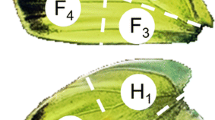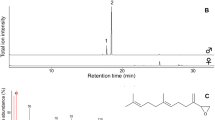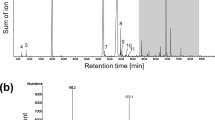Abstract
Pierinae, the major subfamily of Pieridae, is characterized by possessing scent scales as androconia on male wings, which are most likely to disperse volatile substances. However, the chemistry of androconial substances is known for very few species. The yellow tip Anthocharis scolymus Butler (Pierinae: Anthocharidini) is a univoltine pierine butterfly distributed in East Asia. Male adults of this species emit a subtle floral scent, while females are scentless. We revealed that the male-specific scent consists of (S)-(+)-linalool and (E)-β-farnesene, which had never been discovered in Pieridae. Moreover, these volatile terpenoids were more abundant in the wings than in the body, and were distributed from the basal to the distal regions of each wing. Unlike other pierine species, A. scolymus males lacked alar scent scales but had round saccular structures connected to the socket of the ordinary scale in the wing membrane. The morphology of this structure was very similar to those of the intermembranous scent-producing organs of male wings in the subfamily Coliadinae. Although scent scales are found in the genus Anthocharis, the presence of male-specific scents has not been reported so far. The present study illustrates unique characters of A. scolymus in both androconial chemistry and morphology in Pierinae.






Similar content being viewed by others
References
Andersson J, Borg-Karlson A-K, Vongvanich N, Wiklund C (2007) Male sex pheromone release and female mate choice in a butterfly. J Exp Biol 210:964–970. doi:10.1242/jeb.02726
Bergström G, Lundgren L (1973) Androconial secretion of three species of butterflies of the genus Pieris (Lep., Pieridae). Zoon Suppl 1:67–75
Bolg-Karlson A-K, Tengö J, Valterová I, Unelius CR, Taghizadeh T, Tolasch T, Francke W (2003) (S)-(+)-Linalool, a mate attractant pheromone component in the bee Colletes cunicularius. J Chem Ecol 29:1–14. doi:10.1023/A:1021964210877
Braby MF (2005) Provisional checklist of genera of the Pieridae (Lepidoptera: Papilionoidea). Zootaxa 832:1–16
Braby MF, Vila R, Pierce NE (2006) Molecular phylogeny and systematics of the Pieridae (Lepidoptera: Papilionoidea): higher classification and biogeography. Zool J Linn Soc 147:239–275. doi:10.1111/j.1096-3642.2006.00218.x
Chew FS, Watt WB (2006) The green-veined white (Pieris napi L.), its pierine relatives, and the systematics dilemmas of divergent character sets (Lepidoptera, Pieridae). Biol J Linn Soc 88:413–435. doi:10.1111/j.1095-8312.2006.00630.x
Dawson GW, Griffiths DC, Merritt LA, Mudd A, Pickett JA, Wadhams LJ, Woodcock CM (1990) Aphid semiochemicals—a review, and recent advances on the sex pheromone. J Chem Ecol 16:3019–3030. doi:10.1007/BF00979609
Dixey FA (1932) The plume-scales of the Pierinae. Trans Entomol Soc Lond 80:57–75. doi:10.1111/j.1365-2311.1932.tb00082.x
Dötterl S, Burkhardt D, Weißbecker B, Jürgens A, Schütz S, Mosandl A (2006) Linalool and lilac aldehyde/alcohol in flower scents, electrophysiological detection of lilac aldehyde stereoisomers by a moth. J Chromatogr A 1113:231–238. doi:10.1016/j.chroma.2006.02.011
Ehrlich PR (1958) The comparative morphology, phylogeny and higher classification of the butterflies (Lepidoptera: Papilionoidea). Univ Kansas Sci Bull 39:305–370
Geiger HJ (1980) Enzyme electrophoretic studies on the genetic relationships of pierid butterflies (Lepidoptera: Pieridae) I. European taxa. J Res Lepid 19:181–195
Gershenzon J, Dudareva N (2007) The function of terpene natural products in the natural world. Nat Chem Biol 3:408–414. doi:10.1038/nchembio.2007.5
Grujic-Jovanovic S, Skaltsa HD, Marin P, Sokovic M (2004) Composition and antibacterial activity of the essential oil of six Stachys species from Serbia. Flavour Fragr J 19:139–144. doi:10.1002/ffj.1275
Grula JW, McChesney JD, Taylor OR Jr (1980) Aphrodisiac pheromones of the sulfur butterflies Colias eurytheme and C. philodice (Lepidoptera, Pieridae). J Chem Ecol 32:435–451. doi:10.1007/BF00987543
Hall JPW, Harvey DJ (2002) A survey of androconial organs in the Riodinidae (Lepidoptera). Zool J Linn Soc 136:171–197. doi:10.1046/j.1096-3642.2002.00003.x
Hayashi N, Kuwahara Y, Komae H (1978) The scent scale substances of male Pieris butterflies (Pieris melete and Pieris napi). Experientia 34:684–685. doi:10.1007/BF01947255
Hayashi N, Nishi A, Murakami T, Maeshima K, Komae H, Sakao T (1985) The scent substances of pierid butterflies (Hebomoia glaucippe Linnaeus) and the volatile components of their food plants (Crataeva religiosa Forst.). Z Naturforsch C 40:47–50
Heil M (2008) Indirect defense via tritrophic interactions. New Phytol 178:41–61. doi:10.1111/j.1469-8137.2007.02330
Knudsen JT, Eriksson R, Gershenzon J, Ståhl B (2006) Diversity and distribution of floral scent. Bot Rev 72:1–120. doi:10.1663/0006-8101(2006)72[1:DADOFS]2.0.CO;2
Kristensen NP, Simonsen TJ (2003) ‘Hairs’ and cells. In: Kristensen NP, Simonsen TJ (eds) Lepidoptera, moths and butterflies. Vol. 2: Morphology, physiology, and development. Handbuch der Zoologie/Handbook of Zoology IV/36. Walter de Gruyter, Berlin and New York, pp 9–22
Kuwahara Y (1979) Scent scale substances of male Pieris melete Ménétriès (Pieridae: Lepidoptera). Appl Entomol Zool 14:350–355. doi:10.1303/aez.14.350
Larsdotter-Mellström H, Murtazina R, Borg-Karlson A-K, Wiklund C (2012) Timing of male sex pheromone biosynthesis in a butterfly—different dynamics under direct or diapause development. J Chem Ecol 38:584–591. doi:10.1007/s10886-012-0126-6
Martin DM, Gershenzon J, Bohlmann J (2003) Induction of volatile terpene biosynthesis and diurnal emission by methyl jasmonate in foliage of Norway spruce. Plant Physiol 132:1586–1599. doi:10.1104/pp.103.021196
Nakai M, Honda K, Ueda H, Ômura H (2001) Is androconial secretion of Pieris napi (Lepidoptera: Pieridae) chemically dimorphic? Trans Lepid Soc Jpn 52:309–312
Okamoto T, Kawakita A, Goto R, Svensson GP, Kato M (2013) Active pollination favours dimorphism in floral scent. Proc R Soc B 280:20132280. doi:10.1098/rspb.2013.2280
Ômura H, Honda K (2005) Chemical composition of volatile substances from adults of the swallowtail, Papilio polytes (Lepidoptera: Papilionidae). Appl Entomol Zool 40:421–427. doi:10.1303/aez.2005.421
Ômura H, Honda K (2011) Pungent odor of the adult skipper butterfly Erynnis montanus (Lepidoptera: Hesperiidae). Appl Entomol Zool 46:281–286. doi:10.1007/s13355-011-0039-9
Ômura H, Yotsuzuka S (2015) Male-specific epicuticular compounds of the sulfur butterfly Colias erate poliographus (Lepidoptera: Pieridae). Appl Entomol Zool 50:191–199. doi:10.1007/s13355-015-0321-3
Ômura H, Morinaka S, Honda K (2000) Chemical nature of volatile compounds from the valvae and wings of male Delias butterflies (Lepidoptera: Pieridae). Entomol Sci 2000:427–432
Ômura H, Yanai N, Honda K (2012) Sexual dimorphism in scent substances and cuticular lipids of adult Papilio protenor butterflies. Z Naturforsch C 67:331–341
Ômura H, Itoh T, Wright DM, Pavulaan H, Schröder S (2015) Morphological study of alar androconia in Celastrina butterflies. Entomol Sci 18:353–359. doi:10.1111/ens.12126
Raguso RA, Pichersky E (1999) A day in the life of a linalool molecule: chemical communication in a plant-pollinator system. Part 1: Linalool biosynthesis in flowering plants. Plant Spec Biol 14:95–120. doi:10.1046/j.1442-1984.1999.00014.x
Robbins RK, Henson PM (1986) Why Pieris rapae is a better name than Artogeia rapae (Pieridae). J Lep Soc 40:79–92
Rutowski RL (1977) Chemical communication in the courtship of the small sulphur butterfly Eurema lisa (Lepidoptera, Pieridae). J Comp Physiol A 115:78–85. doi:10.1007/BF00667786
Savela M (2015) Lepidoptera and some other life forms. http://www.nic.funet.fi/pub/sci/bio/life/intro.html. Accessed 15 Dec 2015
Schulz S, Francke W, Edgar J, Schneider D (1988) Volatile compounds from androconial organs of danaine and ithomiine butterflies. Z Naturforsch C 43:99–104
Scott JA (1972) Mating of butterflies. J Res Lepid 11:99–127
Turlings TCJ, Loughrin JH, McCall PJ, Röse USR, Lewis WJ, Tumlinson JH (1995) How caterpillar-damaged plants protect themselves by attracting parasitic wasps. Proc Natl Acad Sci USA 95:4169–4174
Vetter RS, Rutowski RL (1978) External sex brand morphology of three sulphur butterflies (Lepidoptera: Pieridae). Psyche 85:383–393. doi:10.1155/1978/78397
Wahlberg N, Rota J, Braby MF, Pierce NE, Wheat CW (2014) Revised systematic and higher classification of pierid butterflies (Lepidoptera: Pieridae) based on molecular data. Zool Scr 43:641–650. doi:10.1111/zsc.12075
Warren BCS (1961) The androconial scales and their bearing on the question of speciation in the genus Pieris (Lepidoptera). Entomol Tidskr Arg 82:121–148
Wiklund C, Forsberg J (1985) Courtship and male discrimination between virgin and mated females in the orange tip butterfly Anthocharis cardamines. Anim Behav 34:328–332. doi:10.1016/S0003-3472(86)80100-2
Yildizhan S, van Loon J, Sramkova A, Ayasse M, Arsene C, ten Broeke C, Schulz S (2009) Aphrodisiac pheromones from the wings of the small cabbage white and large cabbage white butterflies, Pieris rapae and Pieris brassicae. Chem Bio Chem 10:1666–1677. doi:10.1002/cbic.200900183
Yoshida A, Noda A, Yamana A, Numata H (2000) Arrangement of scent scales in the male wings of the small white cabbage butterfly (Lepidoptera: Pieridae). Entomol Sci 3:345–349
Author information
Authors and Affiliations
Corresponding author
Electronic supplementary material
Below is the link to the electronic supplementary material.
Rights and permissions
About this article
Cite this article
Okumura, Y., Ozeki, Y., Itoh, T. et al. Volatile terpenoids from male wings lacking scent scales in Anthocharis scolymus (Lepidoptera: Pieridae). Appl Entomol Zool 51, 385–392 (2016). https://doi.org/10.1007/s13355-016-0410-y
Received:
Accepted:
Published:
Issue Date:
DOI: https://doi.org/10.1007/s13355-016-0410-y




